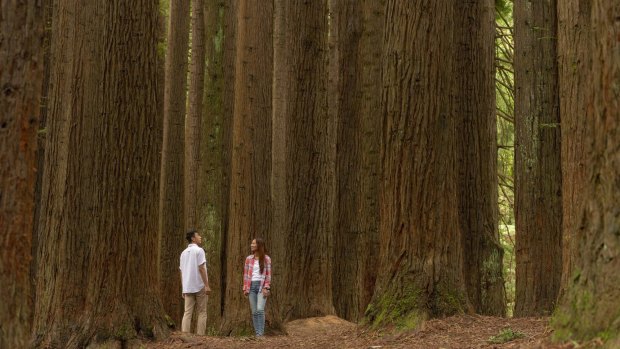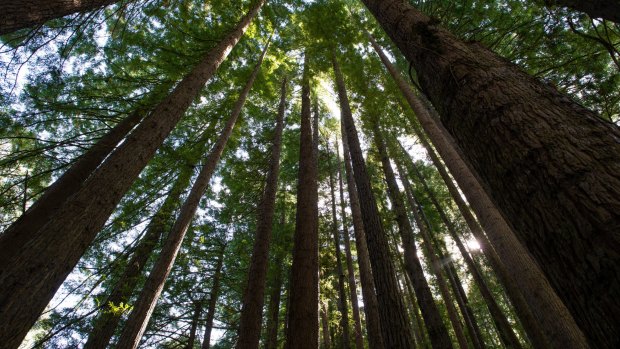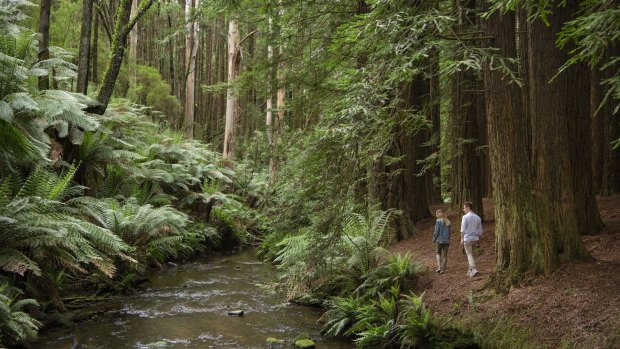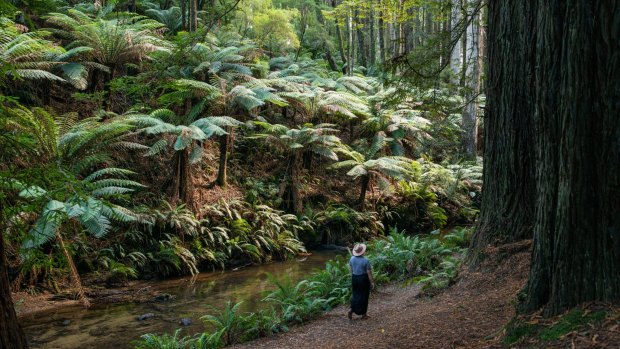This was published 2 years ago
California redwood forest, Aire Valley Reserve: Land of giants one of Victoria's best-kept secrets
By Mark Daffey

The California redwood forest in the Aire Valley Reserve, bordering the Great Otway National Park, has been described as one of the best-kept secrets in Victoria.Credit: Visit Victoria
The rising sun warms the forest canopy far above me as I weave between some of the tallest trees in the world. At ground level, there's barely any hint of dawn; natural light fails to penetrate. And it's deathly silent, save for the gentle burbling of the Aire River through this part of the Otway Ranges, 200 kilometres southwest of Melbourne.
The California redwood forest in the Aire Valley Reserve, bordering the Great Otway National Park, has been described as one of the best-kept secrets in Victoria – hidden in plain sight, and yet thousands of kilometres from the redwood's natural habitat.
Found close to Beech Forest, a potato-farming region that briefly basked in the limelight of being the hometown of shuffling ultramarathon runner Cliff Young during the 1980s, they took root during an experiment that was conducted close to 100 years ago, when the Forests Commission of Victoria planted six trial plots containing 460 seedlings as part of an expansion program to meet the growing timber needs of the housing and construction industries.

Now roughly 90 years old, some have reached heights exceeding 60 metres.Credit: Emily Godfrey
Native hardwood eucalypts were readily available for logging at that time, so the planting of these towering softwoods were a break from convention. Experts had noticed similarities in soil composition and climate in the Otways compared with the redwoods' customary habitat in northern California and the southwest part of Oregon, so the risk of the trees not growing was deemed minimal. A similar experiment was conducted near Warburton, east of Melbourne.
The redwoods grew slowly at first, averaging just five metres tall after 15 years. But as they matured, they began to flourish. Now roughly 90 years old, some have reached heights exceeding 60 metres.
Unsurprisingly, the tallest redwood in the world can be found in California. Called Hyperion, it tops out at 115 metres and is believed to be around 1000 years old. The Otways redwoods are minnows in comparison, though they are also much younger. But at their current rate of growth, forestry pundits predict they may even outstrip their forebears north of the equator.

Tree ferns line the banks of the river, where fallen tree trunks carpeted in luscious mosses form natural bridges for animals to cross.Credit: Visit Victoria
The tallest tree in Australia at present is a 100-metre mountain ash in Tasmania's Arve Valley, west of Geeveston. Appropriately, it's called Centurion. And although these Otway redwoods are mighty impressive, they are not even the tallest trees in Victoria. That mantle belongs to some mountain ashes in the Yarra Ranges.
I've driven down from Melbourne via Colac, though a popular alternative is to travel here along the Great Ocean Road through Lorne. It's an area that's surrounded by some of the prettiest waterfalls in the state. Hopetoun Falls is barely a kilometre from the redwood forest. Beauchamp Falls is close by; Triplet Falls a little further. Other waterfalls are found around Lorne and the biggest along this coastal rainforest region, Carisbrook Falls, is near Skenes Creek. It can be observed at the end of a walking trail that climbs to a viewing platform, not far from the highway.
Fallen leaves absorb my footsteps as I venture further into the forest, either side of the Aire River. Fed by an average 235 days of rainfall each year, the river begins its journey near Beech Forest. It then follows a meandering course until it spills into the Southern Ocean at Hordern Vale, west of Cape Otway.

The Forests Commission of Victoria planted six trial plots containing almost 100 years ago as part of an expansion program to meet the growing timber needs of the housing and construction industries.Credit: Visit Victoria
Tree ferns line the banks of the river, where fallen tree trunks carpeted in luscious mosses form natural bridges for animals to cross. The surrounding forests are home to tiger quolls, echidnas and potoroos, and at one point I think I spy a platypus in the shallows. It is not beyond the realms of possibility, although sightings are rare. They are found around these parts, most notably in Lake Elisabeth, near the town of Forrest.
As wondrous as these trees are, I can't help but feel insignificant next to them, like a hobbit stumbling into a foreign world. The realisation that we are merely spectators in the cycle of life also comes to mind. Provided their preservation remains assured, we'll be long gone by the time these infants perish.
The writer travelled at his own expense.
See also: Ten higlights of Victoria's Great Ocean Road
See also: Where to find the world's tallest trees
Sign up for the Traveller Deals newsletter
Get exclusive travel deals delivered straight to your inbox. Sign up now.